The Organic Rice Protein Market is estimated to be valued at USD 117.4 million in 2025 and is projected to reach USD 175.5 million by 2035, registering a compound annual growth rate (CAGR) of 4.1% over the forecast period.
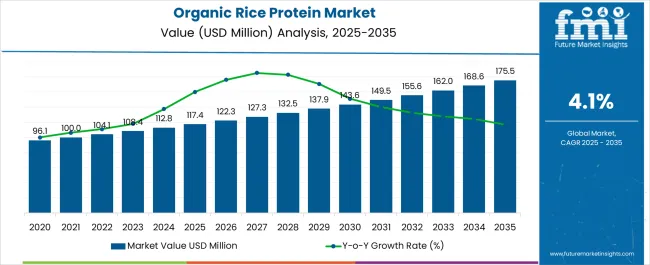
| Metric | Value |
|---|---|
| Organic Rice Protein Market Estimated Value in (2025 E) | USD 117.4 million |
| Organic Rice Protein Market Forecast Value in (2035 F) | USD 175.5 million |
| Forecast CAGR (2025 to 2035) | 4.1% |
The organic rice protein market is gaining momentum as clean-label nutrition trends, plant-based diets, and allergen-free supplement demand converge across global food, beverage, and nutraceutical sectors. Manufacturers are prioritizing traceability, non-GMO sourcing, and solvent-free processing methods, driven by stringent organic certifications and growing consumer scrutiny.
The market is further supported by functional food expansion, as rice protein’s digestibility and amino acid profile make it suitable for sports, pediatric, and geriatric nutrition. Increasing research into protein blending and improved flavor masking has widened the application scope.
Environmental concerns and the need for sustainable protein production are also accelerating adoption, especially in regions with rising vegan and flexitarian populations. Growth opportunities are emerging through the introduction of organic isolates, enhanced extraction technologies, and fortified ready-to-drink health beverages targeting performance and recovery nutrition.
The market is segmented by Extraction Process, Type, Application, and End-User and region. By Extraction Process, the market is divided into Hexane Free Protein Extraction, Low-temperature Protein Extraction, Chemical Extraction, and Physical Extraction. In terms of Type, the market is classified into Isolates, Concentrates, Hydrolysates, and Ion Exchange. Based on Application, the market is segmented into Nutritional Supplements, Baking, General Foods, Functional Applications, General Applications, Flavour Enhancements and Savoury Flavours, Dispersibility, Emulsification, and Others. By End-User, the market is divided into Sports and Energy Nutrition, Dairy, Bakery and Confectionery, Beverages, Meat extenders, and Others. Regionally, the market is classified into North America, Latin America, Western Europe, Eastern Europe, Balkan & Baltic Countries, Russia & Belarus, Central Asia, East Asia, South Asia & Pacific, and the Middle East & Africa.
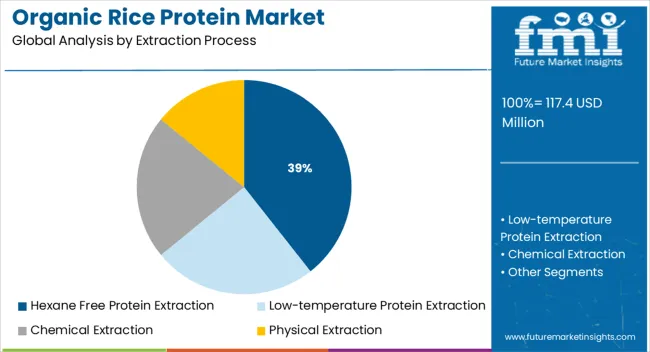
Hexane free protein extraction is projected to account for 39.4% of the organic rice protein market revenue in 2025, making it the leading extraction method. This growth is being driven by rising demand for solvent-free, environmentally safe, and organically certified processing technologies.
The method ensures higher purity while eliminating chemical residues, aligning with clean-label positioning favored by functional food and nutraceutical brands. Consumer distrust of chemical processing and growing adoption of organic verification systems have prompted producers to eliminate petrochemical solvents entirely.
Additionally, regulatory tightening around food-grade solvent use and manufacturer focus on water-based or mechanical separation techniques have made hexane free processes commercially attractive and compliant with evolving standards in North America and Europe.
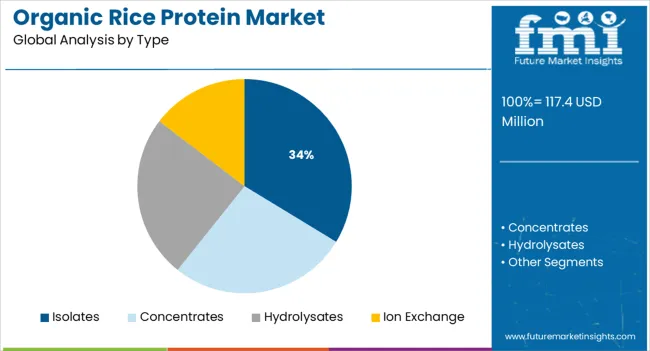
Isolates are expected to contribute 33.7% of total market revenue by 2025, making them the dominant protein type in the organic rice protein market. This leadership is attributed to their high protein concentration, low fat and carbohydrate content, and suitability in performance-focused nutritional formulations.
Their neutral flavor and solubility profile allow for seamless incorporation into shakes, bars, and beverages without compromising taste or texture. Isolates have become especially popular among sports nutrition and weight management brands seeking hypoallergenic, plant-derived alternatives to whey or soy.
The segment’s rise is further supported by processing advancements that reduce grittiness and improve amino acid balance. As health-conscious consumers demand nutrient-dense, low-calorie solutions, isolates continue to gain traction in both mass market and premium supplement categories.
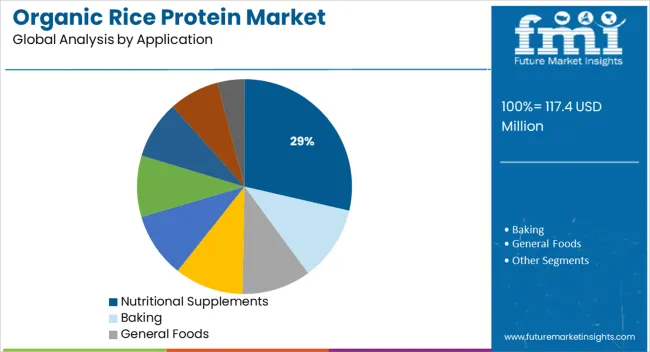
Nutritional supplements are projected to generate 28.6% of revenue in the organic rice protein market by 2025, ranking it as the leading application segment. This dominance is being influenced by increased awareness of plant-based performance nutrition and the growing popularity of vegan lifestyle products.
Organic rice protein offers a clean, hypoallergenic base for supplement formulations targeting muscle recovery, endurance, and general wellness. The segment is further propelled by innovation in functional blends combining rice protein with pea, hemp, or quinoa for enhanced amino acid profiles.
Consumers are increasingly drawn to naturally sourced products free from artificial additives, propelling demand for transparent labeling and organic certification. E-commerce expansion and direct-to-consumer wellness brands have also contributed to wider adoption, positioning rice protein as a versatile ingredient in both powder and ready-to-consume formats.
Organic Rice Protein is one of the oldest and most popular plant-based proteins. It has a long history of use in Asia and is now gaining popularity in the Western world. Despite its ancient origins, the organic rice protein market is still in its infancy. The market was worth just over USD 112.8 Million in 2024 and is expected to grow to USD 175.5 Million by 2035, according to a report by Future Market Insights.
This growth is expected to continue in the future, as more and more people become aware of the benefits of Organic Rice Protein. The main drivers of this growth are expected to be the health-conscious consumer and the growing demand for plant-based proteins.
North America accounted for more than 50% of the global market in 2024, driven by growing demand for sports drinks in Canada and the USA. During the forecast period, the market expansion is likely to be fueled by the presence of key manufacturers and organic rice protein suppliers in the USA.
Moreover, the high demand for natural food ingredients is expected to further drive the USA organic rice protein market size. However, the USA accounted for 32.7% market share with a market value of USD 34.1 Million during the forecast period.
The United Kingdom market for organic rice protein powder is a leading contributor in the Europe region during the forecast period. People in the United Kingdom prefer organic rice protein because it is a good choice for those who are looking for an alternative to animal-based proteins.
It is also a good option for people who are allergic to soy or nuts. Rice protein is easy to digest and has a neutral flavor, making it versatile in recipes. During the forecast period, the United Kingdom organic rice protein market is expected to grow at a CAGR of 5.8%.
According to the FMI report, the Asia Pacific region is the fastest-growing region in the organic rice protein market during the forecast period. The countries such as Korea and Japan are flourishing in the market size in the region.
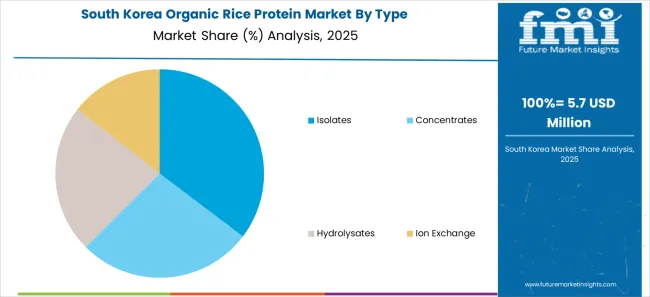
The Korean organic rice protein market is surging rapidly by increasing demand from consumers for healthy and sustainable food products during the forecast period. The Korean government supports organic agriculture and promotes rural development, which has contributed to the growth of the Korean organic rice protein market in recent years.
In addition, the rising demand for plant-based proteins by end-users drives the Korean organic rice protein market share. Moreover, the vast Korean territory and favorable climate conditions are suitable for cultivating organic rice to increase the market size.
Japan's organic rice protein market is also contributing a significant share of the global market during the foreseen time. Due to the growing health consciousness of consumers and the trend towards healthy diets, the Japanese market for organic rice protein is upsurging during the forecast period.
Due to rising awareness related to low-fat and calorie food among consumers, the Japanese organic rice protein market share is growing higher in recent years due to significant investment by numerous market players and the low cost of the product upsurging the Japanese market during the forecast period. The organic rice protein manufacturer develops food proteins without changing the product's texture, flavor, quality, or appearance.
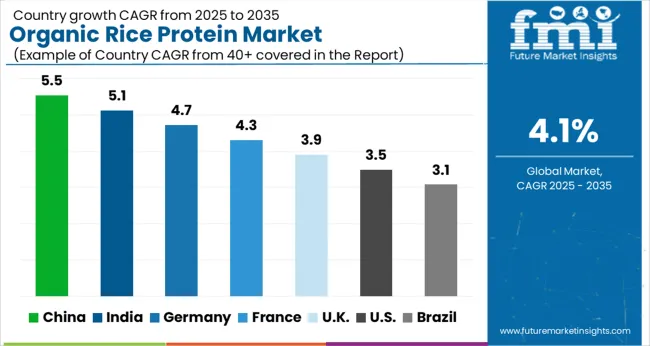
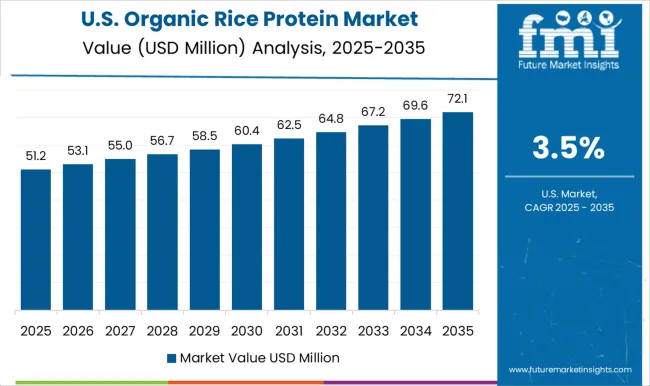
North America accounted for more than 50% of the global market in 2024, driven by growing demand for sports drinks in Canada and the USA. During the forecast period, the market expansion is likely to be fuelled by the presence of several of these key manufacturers.
High demand for natural food ingredients is expected to further drive the expansion of the Organic Rice Protein market. The USA accounted for 32.7% market share with a market value of USD 117.4 Million in 2025.
The Organic Rice Protein market is growing in the United Kingdom for a number of reasons. People in the United Kingdom prefer Organic Rice Protein because it is a good choice for those who are looking for an alternative to animal-based proteins. It is also a good option for people who are allergic to soy or nuts. Rice protein is easy to digest and has a neutral flavor, making it versatile in recipes.
During the forecasted period, Organic Rice Protein Market in the United Kingdom is expected to grow at a CAGR of 5.8%.
According to FMI’s analysis, China is anticipated to grow at a CAGR of 5.1% between 2025 and 2035. The Organic Rice Protein Market in China is expected to grow at a rapid pace in the coming years, due to the increasing demand from consumers for healthy and sustainable food products.
The Chinese government's policies to support organic agriculture and promote rural development will also contribute to the growth of the market. Moreover, China's vast territory and favorable climate conditions are suitable for cultivating organic rice, which will further drive market growth.
In recent years, the Organic Rice Protein market has seen significant growth. This is due in part to the growing health consciousness of consumers and the trend toward plant-based diets. India is one of the leading producers of Organic Rice Protein, and its performance in this market is impressive. India is expected to grow at a CAGR of 5.6% during the forecasted period.
The main drawback of Organic Rice Protein is that it’s not as easily absorbed by the body as other proteins. But this can be remedied through a process called chemical extraction. Chemical extraction involves using chemicals to remove the non-protein parts of the rice grain, leaving behind a more concentrated form of protein. This process makes Organic Rice Protein more bioavailable, meaning your body can better absorb and use it.
Due to significant investment by numerous market players and the low cost of the product, concentrates are gradually growing. Concentrates can replace goods like food proteins without changing the product's texture, flavor, or appearance.
The consumption of Organic Rice Protein in Sports and Energy nutrition is attributable to their high amino acid profile and presence of branched-chain amino acids (BCAAs), which are crucial for muscle repair in athletes and bodybuilders. Weight management is the primary reason for the use of Organic Rice Protein in Sports and Energy nutrition.
Similar to whey protein, rice proteins promote increased lean body mass, skeletal muscle hypertrophy, power, and strength.
Organic Rice Protein is becoming an increasingly popular choice for those looking for a healthy, sustainable option. There are a number of factors that are propelling the growth of Organic Rice Protein, including the health benefit it offers and the increasing awareness of the importance of sustainability.
Organic Rice Protein is a healthy alternative to other protein sources, such as animal-based proteins. It is low in fat and cholesterol and contains no artificial ingredients or preservatives. Additionally, Organic Rice Protein is a sustainable choice, as it requires less water and energy to produce than other protein sources.
Key players’ strategies include alliances and agreements. By forming alliances and expanding their distribution networks, businesses are trying to reach a wider worldwide audience. Major manufacturers are investing heavily in Research and Development to develop high-quality products, which is expected to boost competition among them.
The FMI team has also kept track of recent developments in businesses that produce Organic Rice Protein, and these developments are included in the full market report.
| Attribute | Details |
|---|---|
| Forecast Period | 2025 to 2035 |
| Historical Data Available for | 2020 to 2025 |
| Market Analysis | USD Million for Value and Units for Volume |
| Key Regions Covered | North America; Latin America; Europe; Asia Pacific; Middle East and Africa(MEA) |
| Key Countries Covered | United States of America, Canada, Mexico, Germany, United Kingdom, France, Italy, Spain, China, Japan, India, South Korea, Australia, Brazil, Argentina, South Africa, United Arab Emirates(UAE) |
| Key Segments Covered | Extraction Process, Type, Application, End-user |
| Key Companies Profiled | Axiom Foods; RiceBran Technologies; AIDP Inc; Golden Gropud Limited; Shaanxi Fuheng Biotechnology Co. Ltd.; Nutrition Resource Inc.; Bioway Organic Ingredients Co. Ltd; Top Health Ingredients Inc. |
| Report Coverage | Market Forecast, Company Share Analysis, Competitive Landscape, Drivers, Restraints, Opportunities and Threats Analysis, Market Dynamics and Challenges, and Strategic Growth Initiatives |
| Customization & Pricing | Available upon Request |
The global organic rice protein market is estimated to be valued at USD 117.4 million in 2025.
The market size for the organic rice protein market is projected to reach USD 175.5 million by 2035.
The organic rice protein market is expected to grow at a 4.1% CAGR between 2025 and 2035.
The key product types in organic rice protein market are hexane free protein extraction, low-temperature protein extraction, chemical extraction and physical extraction.
In terms of type, isolates segment to command 33.7% share in the organic rice protein market in 2025.






Full Research Suite comprises of:
Market outlook & trends analysis
Interviews & case studies
Strategic recommendations
Vendor profiles & capabilities analysis
5-year forecasts
8 regions and 60+ country-level data splits
Market segment data splits
12 months of continuous data updates
DELIVERED AS:
PDF EXCEL ONLINE
Organic Cosmetics Market Size and Share Forecast Outlook 2025 to 2035
Organic Salad Dressing Market Forecast and Outlook 2025 to 2035
Organic Fertilizer Market Size and Share Forecast Outlook 2025 to 2035
Organic Acai Juice Market Size and Share Forecast Outlook 2025 to 2035
Organic Beverages Market Size and Share Forecast Outlook 2025 to 2035
Organic Drinks Market Size and Share Forecast Outlook 2025 to 2035
Organic Oats Market Size and Share Forecast Outlook 2025 to 2035
Organic Dried Distillers Grain Feed Market Size and Share Forecast Outlook 2025 to 2035
Organic Hemp Market Size and Share Forecast Outlook 2025 to 2035
Organic Electronics Market Size and Share Forecast Outlook 2025 to 2035
Organic Dyes Market Size and Share Forecast Outlook 2025 to 2035
Organic Rankine Cycle Market Size and Share Forecast Outlook 2025 to 2035
Organic Seed Varieties Market Size and Share Forecast Outlook 2025 to 2035
Organic Lamb Market Size and Share Forecast Outlook 2025 to 2035
Organic Snack Food Market Size and Share Forecast Outlook 2025 to 2035
Organic Hydrosols Market Size and Share Forecast Outlook 2025 to 2035
Organic Trace Minerals Market Analysis - Size, Share, and Forecast Outlook 2025 to 2035
Organic Food and Beverage Market Analysis - Size, Share, and Forecast Outlook 2025 to 2035
Organic Starch Market - Size, Share, and Forecast Outlook 2025 to 2035
Organic Fruit Powder Market Size, Growth, and Forecast for 2025 to 2035

Thank you!
You will receive an email from our Business Development Manager. Please be sure to check your SPAM/JUNK folder too.
Chat With
MaRIA